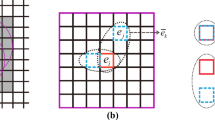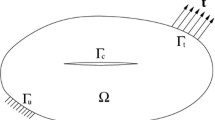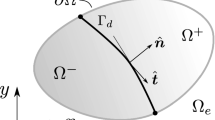Abstract
The finite element method has been widely used to solve different problems in the field of fracture mechanics. In the last two decades, new methods have been developed to improve the accuracy of the solution in 2D linear elastic fracture mechanics problems, such as the extended finite element method (XFEM) or the phantom node method (PNM). The goal of this work is to quantify the differences between some numerical approaches: standard finite element method (FEM), mechanical property degradation, interelemental crack method with multi-point constraints, XFEM and PNM. We explain the different techniques analysed together with their advantages and disadvantages. We compare these numerical techniques to model fracture using problems of reference with known solutions, evaluating their behaviour in terms of convergence with respect to the element size and accuracy of the stress intensity factor (SIF), stresses ahead the crack tip and crack propagation prediction. Some of the new techniques have shown a better accuracy in SIF calculation or stress fields ahead the crack tip and other lead to high errors in local results estimations. However, all methods reviewed here can predict crack propagation for the problems of reference of this work, showing good accuracy in crack orientation prediction.















Similar content being viewed by others
References
Agwai A, Guven I, Madenci E (2010) Comparison of XFEM, CZM and PD for predicting crack initiation and propagation. In: Collection of technical papers—AIAA/ASME/ASCE/AHS/ASC structures, structural dynamics and materials conference
Areias PMA, Belytschko T (2005) Analysis of three-dimensional crack initiation and propagation using the extended finite element method. Int J Numer Methods Eng 63(8):760–788
Argyris JH, Kelsey S (1954) Energy theorems and structural analysis. Aircraft Eng 26(12):410–422
Banks-Sills L (1991) Application of the finite element method to linear elastic fracture mechanics. Appl Mech Rev 44(10):447–461
Banks-Sills L, Sherman D (1986) Comparison of methods for calculating stress intensity factors with quarter point elements. Int J Fract 32:127–140
Banks-Sills L, Sherman D (1992) On the computation of stress intensity factors for three-dimensional geometries by means of the stiffness derivative and J-integral methods. Int J Fract 53:1–20
Belytschko T, Black T (1999) Elastic crack growth in finite elements with minimal remeshing. Int J Numer Methods Eng 45(5):601–620
Bittencourt TN, Barry A, Ingraffea AR (1992) Comparison of mixed-mode stress intensity factors obtained through displacement correlation, J-integral formulation and modified crack-closure integral. In: Fracture mechanics: 22nd Symposium. Atluri SN, Newman,JC Jr, Raju IS, Epstein JS, editors, number II, ASTM STP, Philadelphia, pp 69-82
Bittencourt TN, Wawrzynek PA, Ingraffea AR, Sousa JL (1996) Quasi-automatic simulation of crack propagation for 2D LEFM problems. Eng Fract Mech 55(2):321–334
Bobet A, Einstein HH (1998) Numerical modeling of fracture coalescence in a model rock material. Int J Fract 92:221–252
Bourdin B, Francfort GA, Marigo JJ (2000) Numerical experiments in revisited brittle fracture. J Mech Phys Solids 48:797–826
Clough RW (1960) The finite element method in plane stress analysis, Conference on matrix methods in structural mechanics, ASCE, Pittsburgh, PA: 345-378
Clough RW (1962) The stress distribution of Norfork Dam, structures and materials research. Department of civil engineering, University of California: Series 100, Issue 19, Berkeley
Duflot M (2007) A study of the representation of cracks with level sets. Int J Numer Methods Eng 70(11):1261–1302
Francfort GA, Marigo JJ (1998) Revisiting brittle fracture as an energy minimization problem. J Mech Phys Solids 46(8):1319–1342
Gallagher RH (1978) A review of finite element techniques in fracture mechanics. In: Proceedings of the first international conference on numerical methods in fracture mechanics (Luxmoore AR, Owen DRJ, Hrsg S) Swansea: Pineridge Press, pp 1–25
Gdoutos EE (1993) Fracture mechanics: an introduction. Solid mechanics and its applications. Kluwer Academic Publishers, Dordrecht, Holland
Giner E, Fuenmayor FJ, Baeza L, Tarancón JE (2005) Error estimation for the finite element evaluation of G\(_{{\rm I}}\) and G\(_{{\rm II}}\) in mixed-mode linear elastic fracture mechanics. Finite Elem Anal Des 41:1079–1104
Giner E, Sukumar N, Tarancón JE, Fuenmayor FJ (2009) An Abaqus implementation of the extended finite element method. Eng Fract Mech 76(3):347–368
Hansbo A, Hansbo P (2004) A finite element method for the simulation of strong and weak discontinuities in solid mechanics. Comput Methods Appl Mech Eng 19(33):3523–3540
Henshell RD, Shaw KG (1975) Crack tip elements are unnecessary. Int J Numer Methods Eng 9:495–507
Hibbitt, Karlsson, Sorensen (2004) Inc. ABAQUS/standard user’s manual, Pawtucket, Rhode Island
Ingraffea AR (2004) Computational fracture mechanics. In: Encyclopedia of computational mechanics, 1\(^{{\rm st}}\) edn. Wiley, pp 375-405
Jäger P, Steinmann P, Kuhl E (2008) Modelling three-dimensional crack propagation—a comparison of crack path tracking strategies. Int J Numer Methods Eng 76(9):1328–1352
Jirásek M (2011) Damage and smeared crack models. In: Hofstetter G, Meschke G (eds) Numerical modelling of concrete cracking. Springer, Berlin, pp 1–49
Kanninen MF, Popelar CH (1985) Advanced fracture mechanics. Oxford University Press, Oxford (UK)
Kuna M (2013) Finite elements in fracture mechanics. Theory—numerics—applications. Springer, Berlin
Marco M, Belda R, Miguélez MH, Giner E (2018a) A heterogeneous orientation criterion for crack modelling in cortical bone using a phantom-node approach. Finite Elem Anal Des 146:107–117
Marco M, Giner E, Larraínzar-Garijo R, Caeiro JR, Miguélez MH (2018b) Modelling of femur fracture using finite element procedures. Eng Fract Mech 196:157–167
Moës N, Gravouil A (2002) Non-planar 3D crack growth by the extended finite element method and level sets—part I: mechanical model. Int J Numer Methods Eng 53(11):2549–2568
Moës N, Dolbow J, Belytschko T (1999) A finite element method for crack growth without remeshing. Int J Numer Methods Eng 46:131–150
Oliver J, Huespe AE, Samaniego E, Chaves EWV (2002) On strategies for tracking strong discontinuities in computational failure mechanics. In: Fifth world congress on computational mechanics. Mang HA, Rammerstorfer FC, Eberhardsteiner J. Vienna, Austria, pp 7-12
Ooi ET, Man H, Natarajan S, Song C (2015) Adaptation of quadtree meshes in the scaled boundary finite element method for crack propagation modelling. Eng Fract Mech 144:101–117
Owen DRJ, Fawkes AJ (1983) Engineering fracture mechanics: numerical methods and applications. Pineridge Press Ltd., Swansea
Qian G, Wang M (1996) Symmetric branching of mode II and mixed-mode fatigue crack growth in a stainless steel. J Eng Mater Technol 118:356–361
Qian G, González-Albuixech VF, Niffenegger M, Giner E (2016) Comparison of KI calculation methods. Eng Fract Mech 156:52–67
Rashid YR (1968) Analysis of prestressed concrete reactor vessels. Nucl Eng Des 7:334–334
Rice JR, Tracey DM (1973) Computational fracture mechanics. In: Numerical and computer methods in structural mechanics. Fenves SJ, Perrone N, Robinson AR, Schnobrich WC, Academic Press, New York, pp 585-623
Saouma VE, Ingraffea AR (1981) Fracture mechanics analysis of discrete cracking. In: Proceedings, IABSE colloquium on advanced mechanics of reinforced concrete, Delft 393
Song JH, Wang H, Belytschko T (2008) A comparative study on finite element methods for dynamic fracture. Comput Mech 42:239–250
Staroselsky A, Acharya R, Cassenti B (2019) Phase field modeling of fracture and crack growth. Eng Fract Mech 205:268–284
Stolarska D, Chopp L, Moës N, Belytschko T (2001) Modelling crack growth by level sets in the extended finite element method. Int J Numer Methods Eng 51(8):943–960
Turner MJ, Clough RW, Martin HC, Topp LJ (1956) Stiffness and deflection analysis of complex structures. J Aeronaut Sci 23:805–823
Xu X, Needleman A (1994) Numerical simulation of fast crack growth in brittle solids. J Mech Phys Solids 42(9):1397–1434
Acknowledgements
The authors gratefully acknowledge the funding support received from the Spanish Ministerio de Ciencia, Innovación y Universidades and the FEDER operation program in the framework of the projects DPI2017-89197-C2-1-R and DPI2017-89197-C2-2-R and the FPI subprograms BES-2014-068473 and BES-2015-072070. The financial support of the Generalitat Valenciana through the Programme PROMETEO 2016/007 is also acknowledged.
Author information
Authors and Affiliations
Corresponding author
Additional information
Publisher's Note
Springer Nature remains neutral with regard to jurisdictional claims in published maps and institutional affiliations.
Rights and permissions
About this article
Cite this article
Marco, M., Infante-García, D., Belda, R. et al. A comparison between some fracture modelling approaches in 2D LEFM using finite elements. Int J Fract 223, 151–171 (2020). https://doi.org/10.1007/s10704-020-00426-6
Received:
Accepted:
Published:
Issue Date:
DOI: https://doi.org/10.1007/s10704-020-00426-6




